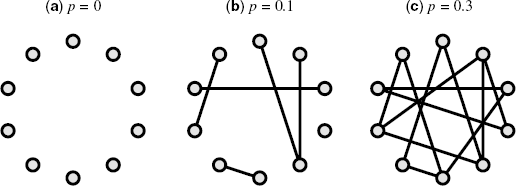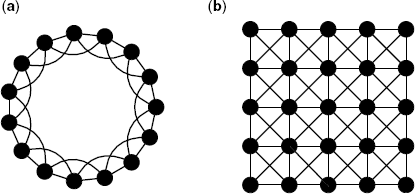2.3 Classical Network
How are real-world networks constructed? Although it is difficult to answer this question, we have used ideal models to discuss network structure.
These models are not in complete agreement with real-world networks (see Section 2.4 and subsequent sections for details). However, these models are the basis of complex networks, and they contribute toward understanding network science in the future. Next, we briefly discuss some classical network models.
2.3.1 Random Network
In 1960, the Erdös–Rényi model (the so-called “random network model”) was proposed by two mathematicians, Erdös and Rényi, with the assumption that networks are randomly constructed because their identities are averaged when the system has many elements [5]. This model is considered in several fields such as sociology, ecology, and mathematical biology because of its simplicity.
In addition, the random network model serves as a foundation for network analysis. Although random networks conflict with real-world networks (see Section 2.4 and subsequent sections for details), we can evaluate the significance of statistical properties observed in real-world networks on the basis of the discrepancy between random networks and real-world ones.
Model networks are generated as follows: supposing N nodes, the edges are drawn between the nodes with probability p. In the case of simple networks, the expected number of edges E is expressed as
(2.2) ![]()
because the total number of possible edges (combinations) is NC2 = N(N − 1)/2. Figure 2.2 shows a schematic diagram of these model networks. As shown in this figure, networks change with the probability p.
Figure 2.2 Schematic diagram of Erdös–Renyi networks for p = 0 (a), p = 0.1 (b), and p = 0.3 (c).

This probability p, which serves as the model parameter, is estimated as
(2.3) ![]()
The number of edges E and the number of nodes N are observable in real-world networks. Thus, these parameters are used for generating hypothetical networks for real-world networks.
2.3.2 Lattice Network
Another famous network model involves lattice networks. Examples of networks of this type are shown in Figure 2.3. These networks are regularly constructed as shown in this figure; thus, they are different from random networks.
Figure 2.3 Examples of lattice networks. An one-dimensional lattice (a) and a two-dimensional lattice (b).

Lattice networks are relatively unsuitable for hypothetical models in network analysis because they seem to be artificial. However, they are useful when considering spatial dimensions such as distance. By assuming the regular networks in mathematical models, further, it may be easy to derive exact solutions of the models because of the regularity of lattice networks. Thus, in addition to the random network model, this model is utilized in various research fields.
